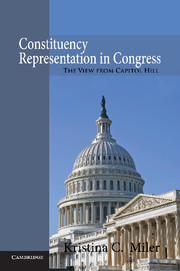Book contents
- Frontmatter
- Contents
- Acknowledgments
- 1 The Unanswered Question of Legislative Perceptions
- 2 A Dyadic Theory of Subconstituency Representation
- 3 The Psychology of Constituency Representation
- 4 Subconstituents Relevant to Health Policy and Natural Resources Policy
- 5 Explaining Legislative Perceptions
- 6 The Effects of Legislative Perception on Participation
- 7 Reassembling the District as a Whole
- 8 Perception, Reform, and Representation in Congress
- Appendix A Sampling
- Appendix B Interviews
- Appendix C Measurement of Primary Independent Variables
- Appendix D Measurement of Legislative Participation
- Appendix E Instrumental Variables Model of Legislative Participation
- References
- Index
6 - The Effects of Legislative Perception on Participation
Published online by Cambridge University Press: 05 October 2010
- Frontmatter
- Contents
- Acknowledgments
- 1 The Unanswered Question of Legislative Perceptions
- 2 A Dyadic Theory of Subconstituency Representation
- 3 The Psychology of Constituency Representation
- 4 Subconstituents Relevant to Health Policy and Natural Resources Policy
- 5 Explaining Legislative Perceptions
- 6 The Effects of Legislative Perception on Participation
- 7 Reassembling the District as a Whole
- 8 Perception, Reform, and Representation in Congress
- Appendix A Sampling
- Appendix B Interviews
- Appendix C Measurement of Primary Independent Variables
- Appendix D Measurement of Legislative Participation
- Appendix E Instrumental Variables Model of Legislative Participation
- References
- Index
Summary
The widespread consensus in the literature on congressional representation is that “constituents matter” when explaining legislators' voting and nonvoting behavior. This familiar phrase provides a useful summary of the relationship between constituents and legislators, but it also leaves much to the imagination. In particular, when concluding that constituents matter, which constituents matter and how do they matter? The preceding chapter reveals that legislators and their staff see an incomplete and unrepresentative subset of their constituents when they look back at their district from Capitol Hill, which suggests that all constituents may not be represented equally. The central question addressed in this chapter, then, is whether biases in perception become biases in representation. More specifically, do legislative perceptions of the constituents in their district affect the actions legislators take on behalf of their district during the policy-making process?
In order to examine the effect of perceptions on representation, it is necessary to consider the practical actions legislators take to represent their constituents on Capitol Hill. An important form of representation is legislators' participation in the committee and floor debate in the House. Participation in these venues is an integral part of the development of public policy in Congress and is consequential for both representation and lawmaking. Furthermore, participation in the congressional debate provides legislators with the opportunity to represent multiple district interests. This flexibility to represent many constituents is critical to analyzing which constituents are represented and how legislative perceptions affect constituency representation.
- Type
- Chapter
- Information
- Constituency Representation in CongressThe View from Capitol Hill, pp. 104 - 130Publisher: Cambridge University PressPrint publication year: 2010



